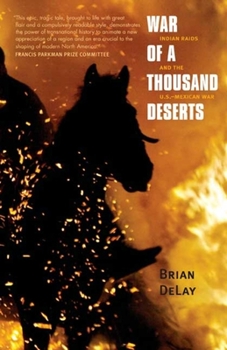War of a Thousand Deserts: Indian Raids and the U.S.-Mexican War
(Part of the The Lamar Series in Western History Series)
Select Format
Select Condition 
Book Overview
An award-winning look at how Apaches, Navajos, Kiowas, and especially Comanches played a decisive role in America's watershed victory over Mexico
Format:Paperback
Language:English
ISBN:0300158378
ISBN13:9780300158373
Release Date:November 2009
Publisher:Yale University Press
Length:496 Pages
Weight:1.56 lbs.
Dimensions:1.2" x 5.8" x 8.9"
Customer Reviews
2 ratings
"A lazy people of vicious character"
Published by Thriftbooks.com User , 15 years ago
The description above is from a Mexican official, Jose Maria Sanchez, writing in 1830 about the North Americans flooding into Texas (then a Mexican state). Manuel Mier y Teran also noted the North Americans' contempt for Mexican laws and refusal to learn the language. The Mexicans clearly saw the threat to their sovereignty, and outlawed immigration from the north. However, the Mexicans were unable to stop the eventuality they clearly foresaw. The Mexican North was a "thousand deserts", laid waste by Comanche raids, terrifying attacks of up to 1,000 warriors who could travel 100 miles a day. Roiling internal politics and a poor economy meant that Mexico did not protect its north from the norteamericano or Indian menaces. American and Mexican willingness to turn a blind eye to buying branded animals created a ready market for stolen livestock. The next time I hear someone extolling Indian simplicity and virtue, I will grit my teeth. The Comanches were renowned for their gratuitous cruelty and devotion to vengeance and retribution, leaving behind "bellowing farm animals dragging their guts behind them",slaughtered noncombatants, some burned alive, and wholesale destruction of grain stocks and wells poisoned with corpses. Because Texans appear to have matched Comanches for ferocity, most of these raids were directed into the Mexico, even as far south as San Luis Potosi and Tamaulipas, victimizing people who were no conceivable threat. Warriors would engage in a scorched earth campaign (as opposed to merely efficiently stealing animals) even when this put them in danger by giving defenders time to organize. There was plenty to seek vengeance for. For instance, in 1846, James Kirker, an American, led a party which slaughtered and scalped 130 unarmed Chiricahua Apaches in Galeana, Chihuahua, to general acclaim from the Mexican populace, an incident which discredited Apache voices advocating peace. All the while, of course, American politicians (especially those looking to expand slave territories)were observing these events with interest, realizing that the Indian raids helped create the opportunity for the United States to acquire northern Mexico, by purchase or conquest. Professor DeLay's gripping book is full of these telling insights. I read this based on a recommendation from Larry McMurtry in The New York Review of Books. Who better to recommend readings on the American Southwest during this period?
A Fascinating Look at an Ignored Subject
Published by Thriftbooks.com User , 16 years ago
When I was taking a course on U.S. Military History for my masters degree, there was one war for which a book was conspicuously absent from the syllabus: The U.S.-Mexico War. When I asked my professor about it, he informed me that he hadn't found a good book that covered some unusual aspect of the war to fit in with the other readings for the class. That book is now here. In War of a Thousand Deserts, Brian DeLay takes on a little known subject from an often neglected period in American history--the effect that Indian raids in northern Mexico had on the U.S. War with that nation. His conclusions about such topics as whether Comanche raids were conducted simply for material gain or also vengeance, or that such raids were as essential a component in the lead-up to the war as any political or expansionist motivations, are backed up by extensive research and pages of data. Professor DeLay is obviously a very careful and conscientious investigator, as evidenced by the outstanding material presented in the appendix. But just as impressive is DeLay's writing style, which avoids the dryness of many scholarly works at this level and makes the story as enjoyable to read as it is informative. I highly recommend this book for anyone interested in U.S., Indian, Mexican, or military history, as well as anyone simply looking for a good read.





